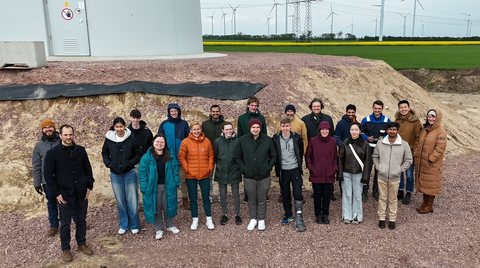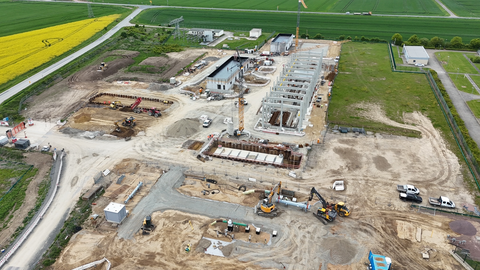May 03, 2024
Excursion to the Bad Lauchstädt Energy Park

The visitors with Mr. Funke at the foot of one of the most modern wind turbines for the production of green hydrogen.
The energy transition and the transition to the active use of green hydrogen require innovative ideas as well as real pilot projects in order to be realized. That's why the Boysen-TU Dresden-Research Training Group visited the Bad Lauchstädt Energy Park on April 24, 2024.

The Bad Lauchstädt energy park viewed from a lofty height.
With its proximity to the chemical industry, a wind farm and underground salt caverns, the energy park is in the perfect location for testing and developing control technologies, production, transportation and storage of green hydrogen. The real-world laboratory is a pioneer in the German hydrogen economy and was therefore presented with the H2Eco Award on April 23, 2024.

Prof. Hurtado visits the construction site of the real laboratory together with the GRK.
The speaker of the Boysen TUD Research Training Group and supervisory board member at VNG AG, Prof. Antonio Hurtado, acted as a link between the project partner VNG AG and the RTG and initially facilitated the meeting. The students were warmly welcomed by Ms. Cornelia Müller-Pagel, Head of Green Gases at VNG AG in Leipzig, and Mr. Richard Funke, Project Manager Green Gases at VNG AG. After a round of introductions by the RTG, in which the clusters presented their individual projects, it quickly became clear that there was great mutual interest in an exchange of knowledge, experience and open questions between the RTG and the operators of the VNG AG energy park. Ms. Cornelia Müller-Pagel then gave a presentation on the energy park, focusing in particular on the development of the salt caverns as a hydrogen storage facility. This led to constructive discussions about the possibilities and challenges of producing and storing green hydrogen.
During the subsequent tour of the construction site of the real laboratory, the Research Training Group gained interesting and informative insights into the design, planning and construction of the planned 30 MW electrolysis plant and its peripherals. This also includes the eight newly built wind turbines, which will also supply renewable energy for the production of green hydrogen. One of the most modern wind turbines of our time could be admired at the end of the tour.

The GRK visitors with the site manager and Ms. Müller-Pagel at the center of the construction site - the foundations for the electrolysers.
This visit laid an important foundation for the Research Training Group's future exchange of experience with VNG and the Bad Lauchstädt energy park, which is due to go into operation in 2025. The students, speakers and managing director would like to thank everyone for the very informative hours and look forward to the upcoming exchange with the stakeholders of this innovative lighthouse project and the opportunities it offers.
